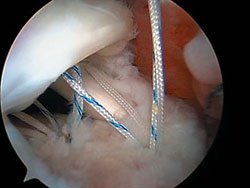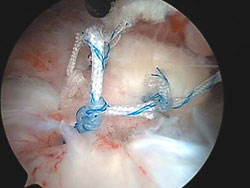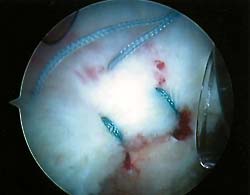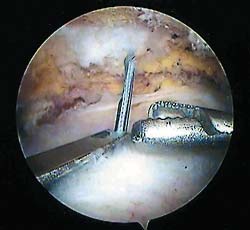Leading practitioners share their insights
Our panel of top surgeons considers best-practice approaches and preferred training regimens for this demanding surgery.
Part II: [Panel shares their insights on rotator cuff repair]
Arthroscopic rotator cuff repair looks set to dominate the field shortly. That makes it a good time for a refresher on the latest thinking. One member of our expert panel below even predicts that four out of five orthopedic surgeons will adopt this procedure as standard treatment within three years. Orthopedics Today asked panel members to consider the top 10 questions on technique, sutures, MRIs, subcromial decompression, postoperative courses, complications and other crucial — and not-so-crucial (“When can I play golf”) — issues.
James Esch, MD
Moderator
| ||||||||||||
James Esch, MD: What is your current technique for an arthroscopic repair of a medium-sized 2-cm to 3-cm cuff repair in a 53-year-old office worker who plays golf and tennis on the weekends? What is your preferred viewing portal? What is your preferred type of suture through the cuff? (Simple? Mattress? T?, etc.) Do you find the newer high strength suture helpful? Do you prefer metal or bioresorbable anchors? Why?
Joseph Tauro, MD: I use a two-portal technique with most viewing from the posterior portal. The lateral portal is used for viewing during the “cutting block” portion of my decompression and for knot tying. I will first do an acromioplasty if the patient has a type 2 or 3 acromion. I detach the coracoacromion (CA) ligament as a sleeve to expose the acromion but I do not transect or excise it. I insert my anchors through a small-stab incision using needle localization and also use small-stab incisions as mini accessory portals for suture management.
After the anchor is inserted, I then retrograde the sutures through the cuff with either a Viper punch or an ExpressSew device. I use a simple suture technique with the new stronger polyethylene-based sutures. My preliminary data on repairs with this type of suture shows somewhat better results. I’ve used all types of screw-in anchors. Metal is cheaper and inserts in one step, without drilling or taping. My preference in anchors is based more on how well the sutures glide through the anchor eyelet.
I have found the Arthrex BioCorkscrew to be the best for this, followed by the Linvatec Super Revo. I’m still doing single-row repairs in primary cases because the two-row repairs are currently too complex, time consuming and expensive, but I’m concerned with the recent data on how many cuff repairs don’t heal. We’re looking into this now by arthroscopically evaluating the motion of the RCR in various arm positions. This may lead to a change in our rehab protocols.
Stephen S. Burkhart, MD: This is obviously a high-demand individual, so I try to repair such tears with a double-row technique if possible. This provides much greater strength than standard single-row techniques. My viewing portal is a posterior viewing portal, and I will alternate between 30º and 70º arthroscopes. For the medial row I use mattress sutures and for the lateral row I use simple sutures. In the case of the patient in which only a single row repair is possible, I will use simple sutures.
I routinely use Fiber wire (sutures) because of the improved loop security and knot security as well as resistance against breakage. I prefer bioabsorbable suture anchors and I have used them exclusively for the past four years. I use screw-in anchors (Bio-Cork screw or Bio-FASTak) and I have not seen any problems with these. There is good patient acceptance of the biodegradable implants, more so than with the metallic implants. The eyelets in these two types of anchors are nice because they are flexible and will allow the suture to slide no matter what direction it is pulled from.
Stephen J. Snyder, MD: My preferred treatment for a medium full-thickness RCT is an arthroscopic repair using two 5-mm metal suture anchors, each with three sutures. I use all-permanent braided sutures and usually have one high-strength #2 polyethylene suture between two strands of #2 polyester suture. I pass the sutures in a special pattern that forms a mattress stitch for the center and simple sutures for the other two. The technique we use is called the “Stitch of Burns” since it was suggested by my current fellow Joseph Burns.
To perform the stitch we make only two passes through the cuff using a 45º Spectrum suture hook and Suture Shuttle Relay. We carry one limb of the posterior suture (the strand that exits the anchor eyelet on the side of the cuff) along with one limb of the middle suture through the cuff with the first pass of the Shuttle 5 mm posterior to the suture anchor. We retrieve and store the two limbs of the posterior (simple) suture in a Suture Saver outside the posterior cannula. The suture hook is passed a second time and the Shuttle carries the second limb of the central suture along with one strand of the anterior suture through the cuff 5 mm anterior to the anchor.
We store both strands of both other sutures in Suture Savers. We insert the second anchor and perform a similar stitching sequence. While performing the cuff repair, I view from a “50-yard line” portal located 2 cm to 3 cm from the lateral edge of the acromion and centered on the mid-point of the cuff tear. I prefer 5-mm metal screw-in anchors for the following reasons: (1) I want to see my anchors on postop X-ray; (2) they are easier to revise if needed; (3) no worry about early anchor breakage or loss of strength from resorption in the intraosseous milieu and, (4) it facilitates suture management. When using three sutures in the stitching pattern I prefer using a metal horizontal eyelet.
|
Richard L. Angelo, MD: I’d use an arthroscopic dual-row repair. I prefer an accessory posterolateral viewing portal — a spinal needle is introduced approximately 1 cm anterior and 2 cm lateral to the posterolateral corner of the acromion and is directed toward the center of the tear seen while viewing from a standard posterior subacromial portal. It may be necessary to adjust this position depending on the location of the cuff tear. This viewing portal frees up the lateral, anterior and posterior subacromial portals for working instruments.
My preferred type of suture through the cuff: two horizontal mattress sutures per each medial row anchor, two simple sutures per each lateral row anchor. I find the high-strength sutures very helpful. The stronger suture material is all we have used for the past several years. In addition to preventing breakage, it allows us to tie tight, secure arthroscopic sliding/locking knots.
I prefer bioresorbable anchors because they provide the opportunity to obtain quality postoperative MRI images if needed and they don’t limit refixation sites should revision be necessary. A downside, though, is that should an anchor become dislodged, which is rare in our experience, imaging may be of little value.
Jeffrey S. Abrams, MD: This is the ideal patient for performing an arthroscopic repair. A single tendon tear in an active, middle-age patient is at risk for tear enlargement with a nonoperative approach. Arthroscopic repair has a high degree of success in tear closure and patient satisfaction.
The posterior portal is most commonly used to visualize the tear. As tears extend posteriorly and medially, a lateral viewing portal may be helpful. Simple sutures attached to suture anchors are used to reattach the tendon to the tuberosity. When tendon mobility allows, surgeons may consider a double-row technique of suture anchor tendon fixation. In this case, the medial anchors utilize mattress sutures, and the lateral row uses simple sutures. Currently, reinforced sutures are preferred to reduce the risk of suture breakage adjacent to the anchor eyelets. Metal suture anchors allow for radiographic confirmation of placement, allow for percutaneous placement without cannulas, and minimize bone reaction.
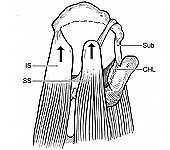 | 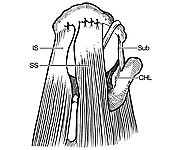 | 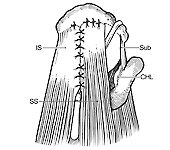 |
The illustration on the left shows the release of the coracohumeral ligament and supraspinatus-infraspinatus (double interval slide). Repair of the supraspinatus to bony footprint with suture anchors (center). Suturing of the supraspinatus to infraspinatus (right). COURTESY OF KENNETH S. BURKHART | ||
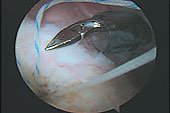 | 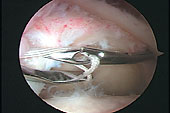 | 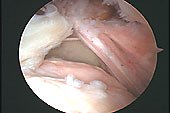 |
The ArthroPierce grasps the Ultrabraid (left). The Cuffstitch to ArthroPierce suture handoff for margin convergence (center). First margin convergence stitch (right). COURTESY OF KENNETH S. BURKHART | ||
Esch: In your practice what is the role of open surgery in the patient with a large or massive cuff tear with atrophy of the supraspinatus and some atrophy of the infraspinatus (The subscapularis is intact)? Is there a size tear that you prefer to do open? Do you do releases in patient with large or massive cuff tears? Capsule? Coracohumeral ligament? Double-Interval Slide? None?
Tauro: I haven’t done an open supraspinatus or infraspinatus repair in almost 10 years. The advantages of an arthroscopic repair only get bigger as the tear size goes up. Since my rate of deltoid and CA ligament morbidity is zero, I can confidently tell these patients that I at least will not make them worse. My two- and three-year follow-up data on these patients shows about an 85% success rate which is not as good as for small tears repairs which are over 95% successful, but I still think its worthwhile to repair these tears in symptomatic patients. I always do a superior capsular release in these cases but I’ve found it necessary to do an interval slide in about 50% in order to mobilize the contracted tears. I know this is more than most folks.
Contracted cuff-tension interval release allows cuff overloads without a release to be repaired under low tension. I’m also doing a double-interval slide in some cases now which I learned from Steve Burkhart but have modified it a bit to keep the supraspinatus and infraspinatus connected — a double-interval slide “in continuity.”
Burkhart: I never do an open surgery for rotator cuff repairs. I will repair all rotator cuff tears arthroscopically.
I do releases in selected patients with large or massive rotator cuff tears. These are patients who have massive, contracted, and adhesed tears, which do not have enough lateral excursion to reach the bone bed and do not have a pattern that allows for margin convergence. In massive tears that include the subscapularis, I will perform an interval slide in continuity, usually combined with a posterior interval slide, for an effective double interval slide equivalent. This particular procedure is reserved for anterosuperior tears involving subscapularis, supraspinatus and infraspinatus. In doing the interval slide in continuity, the coracohumeral ligament is by definition released.
When the subscapularis is intact but there is still so much retraction and adhesion that I cannot obtain enough lateral excursion to get the retracted tendon over to the bone bed, I will do a double interval slide in most cases. In my experience, release of the capsule from the deep surface of the supraspinatus and infraspinatus provides minimal additional lateral excursion. I generally will use it on a limited basis but I do not expect to gain much from it.
COURTESY OF JEFFREY S. ABRAMS |
Snyder: I no longer perform open surgery for any rotator cuff problems. I do use releases for some large, stiff and retracted RCTs. I try to limit the release to the superior capsule and sometimes the rotator interval. I seldom perform the “double release”.
If I encounter a non-repairable cuff tear during arthroscopy I will try to repair it as much as possible and smooth the acromion and AC joint as needed. If the patient fails to improve satisfactorily in the next three months and the joint is not arthritic then I will consider offering the patient an Arthroscopic Graft Jacket Allograft to replace the lost tendon.
Angelo: We have rarely approached a large or massive cuff tear in an open manner in the past three years. As the surgeon gains experience with the arthroscopic view of the anatomy, learns to employ capsular and interval releases, and becomes facile with the various tools needed, large-to-massive tears actually become easier to address arthroscopically. Exposure is enhanced and morbidity minimized. Currently, graft augmentation is our most common indication for open cuff repair.
We occasionally see that a capsular release is of benefit, but find Dr. Tauro’s anterior interval slide is often of significant help in mobilizing the supraspinatus. We have no experience with Dr. Burkhart’s double-interval slide.
Abrams: The approach to a large or massive tear begins arthroscopically. Tendon mobility and quality are assessed. In cases where closure can be achieved, the arthroscopic approach is preferred, regardless of tear size. In irreparable cases, an open approach can be considered to transfer a tendon or place a graft. Selected revision cases with associated deltoid detachments are managed with open techniques to address the cuff and the deltoid.
Arthroscopic releases include a posterior and inferior capsulotomy, bursal releases to visualize the tear margins, and an occasional rotator interval release when the subscapularis is intact. Margin convergence can reduce the size of the defect and create a low-tension repair.
Esch: In your practice how do you approach the patient who has a medium cuff tear and stiffness? The patient I have in my mind cannot lift his arm to put a glass six inches above his head and can barely get his hand into his back pocket?
Tauro: This has been an area of special interest for me over the last three or four years and I have studied the problem in detail. I measure the patient’s ROM deficit in flexion, abduction, internal and external rotation and add them up to determine the total ROM deficit (TROMD). Although capsular abnormalities are common, if the patient has less than a 75º TROMD I have found these patients to have a zero percent chance of having an underlying adhesive capsulitis.
These patients can undergo arthroscopic RCR and will recover their ROM nicely after surgery. It may take six months or a year in rare cases however. If the patient has a TROMD of 75º or more, there is a 50% chance that this patient has adhesive capsulitis and I treat them like other frozen shoulder patients. When they are out of the inflammatory phase and into the “frozen phase,” meaning they no longer have any rest pain, then I do a simultaneous arthroscopic RCR and capsular release. My early data on these patients has been encouraging. If only a RCR is done in these patients, I’ve found that they will remain stiff.
Burkhart: The patient with a medium-sized cuff tear with this level of stiffness is one that should undergo a stretching program prior to surgery and if possible it is preferable to get a full range of motion preoperatively. In general, I will give an intra-articular steroid injection along with a subacromial steroid injection and begin the patient on physical therapy for about three weeks prior to the surgery. In most cases, this will allow restoration of passive range of motion prior to the surgery. If it does not and if the patient still has stiffness at the time of surgery, I will combine selective capsular releases, usually a posterior capsular release, with a rotator cuff repair.
COURTESY OF RICHARD L. ANGELO |
Snyder: If a patient has stiffness and a repairable medium-sized cuff tear I try to improve motion with PT for a few weeks but do not delay the repair too long. I don’t want to risk increased muscle atrophy, osteoporosis and unnecessary prolonged pain and disability. I will manipulate and or release the capsule if needed during the cuff repair and expect a little longer rehab post op.
Angelo: First, aggressive physical therapy and consistent home stretching would be employed. If motion could be improved so that limitations in any single plane were 25º, arthroscopic releases as necessary and cuff repair would be performed. If restrictions exceeded 25º in any plane, consideration for staging would be given. A manipulation and or arthroscopic capsular release is performed followed by aggressive physical therapy. Once motion was acceptable, an arthroscopic rotator cuff repair could be undertaken with a diminished risk of recurrent stiffness.
Abrams: The patient with a stiff shoulder with a medium-size tear can be approached in one or two stages. I prefer to try a single stage release and repair. This would include manipulation, capsulotomy and create a low-tension repair. The early postoperative program is modified to emphasize tendon healing to reduce risk of rupture of the repair. Stretching is progressed after tendon reattachment is secure. These patients often have a more difficult and prolonged postoperative recovery.
Esch: What is the role of subacromial decompression in your patients with a complete rotator cuff tear? Always do? Never do? Partially do?
Tauro: I try to convert all type 2 or 3 acromions to a type 1.
Burkhart: In patients that have an easily repairable tear without proximal migration and without involvement of the subscapularis, I routinely do a subacromial decompression. If there is a large anterosuperior tear, it is my opinion these patients are at greater risk for proximal migration. So, I will do a subacromial smoothing but not a formal decompression. Furthermore, if there is already proximal migration, I will not do a subacromial decompression and will instead preserve the coracoacromial arch.
Snyder: I do perform subacromial decompression in most of my cuff cases if there is any sign of impingement like fraying of the CAL, spurring under the acromion or AC joint or thickening and/or irregularity of the cuff that may cause encroachment between the bone and the cuff. If the bursa is clean I am happy to perform the cuff repair without a SAD.
Angelo: We almost always address the acromion, which varies from acromial “smoothing” for type I or II profiles to a more formal anterior/lateral acromioplasty using a cutting block technique for type III configurations or those with large spurs.
Abrams: A subacromial decompression is done in most cases to assist in pain relief, improve visualization, and create room for instruments. Potential exceptions to decompression include a young patient with acute traumatic tear, and massive irreparable tears that can be destabilized if the subacromial arch is interrupted. In this situation, the coracoacromial ligaments are not detached or resected, and the undersurface of the acromion is burred.
Esch: What do you tell patients about their postoperative course after your arthroscopic repair? When can they comb their hair? When can they play golf? When can they return to the gym and lift weights? Other things you want to include?
COURTESY OF RICHARD L. ANGELO |
Tauro: I have my patients start physical therpy within two or three days and allow full PROM, no AROM for six weeks. At six weeks we start AROM. At 10 weeks we start light PREs and progress slowly as tolerated. When patients can go back to activities depends first on how much of the cuff I was able to repair. Massive repair patients may only get pain relief and improved ability to use the arm when not elevated. For our routine patient above, combing hair at two to three months, golf and light weights at four months, unrestricted activities at six months.
Burkhart: I tell them that they will need to be in a sling for the first six weeks. If this is the dominant arm, they might take the sling off to eat, to shower, and to use the arm for desk work activities. However, they must have the sling on when they are up walking or when they sleep. At six-weeks postop they discontinue the sling and begin overhead stretching. At 12 weeks, they begin strengthening with Theraband. I will not allow them to try to comb their hair with their operated arm until six weeks postop.
For small and medium tears, I will allow them to play golf at six months postop. For large and massive tears, I tell them they should not play golf until one year postop.
For small and medium tears, I will allow them to lift weights at six months postop. For large and massive tears, I allow them to lift weights at one year postop.
Snyder: My postop course for patient activities varies depending on the extent of the surgery and the quality of the tendon and bone. In the usual case: Comb hair — four weeks; golf — three months; chip and putt — six weeks; weights in PT, six weeks slow and smooth. Drive — one week or when not taking narcotics.
Angelo: We stress that pain is worthless as a guide and is often minimal long before the cuff repair is able to tolerate stresses. Although data is limited, we tell patients that it likely takes six months for 75% healing of the repair to occur. Combing hair: three weeks with the operated arm supported by the uninvolved arm. Golf: begin swinging a club for light exercise at three to four months; begin playing a round of golf at five to six months. Very light weights (on the order of one to three pounds at three months; PREs at five to six months. There is a broad range, however, depending on the patient’s age, cuff tear size, bone and soft tissue quality and range-of-motion.
Abrams: Postoperative instructions include a sling, pendulum exercises, and assist-external-rotation initially. Personal hygiene including combing hair can occur within a week. Strengthening is begun at 10 weeks following repair. This may include lifting light weights and use of therabands. Golf and low-impact sports generally begin at 12 to 16 weeks. Tennis and overhead sports will include ground strokes at four months, and overheads and serves at six months. Returning to the gym to lift weights occurs between four to six months.
For more information:
- Dr. Burkhart has a financial interest in products mentioned in this article and also is a paid consultant for Arthure Inc.
- Dr. Snyder as a financial interest a number of products mentioned in this series. He also is a paid consultant to Wright Medical Inc.
Check out part two of this round table in the March issue of Orthopedics Today. Along with moderator James Esch, MD, the panelists discuss how they use MRI in their practices to diagnose rotator cuff injuries and which points of the patient’s history and physical exam are the most important in treating this problem.

![James Esch, MD [photo]](/~/media/images/news/print/orthopedics-today/2005/02_february/esch_70_90_2695.jpg) James Esch, MD,
James Esch, MD,![Jeffrey S. Abrams, MD [photo]](/~/media/images/news/print/orthopedics-today/2005/02_february/abrams_70_90_2695.jpg) Jeffrey S. Abrams, MD,
Jeffrey S. Abrams, MD,![Richard L. Angelo, MD [photo]](/~/media/images/news/print/orthopedics-today/2005/02_february/angelo_70_90_2695.jpg) Richard L. Angelo, MD,
Richard L. Angelo, MD,![Stephen S. Burkhart, MD [photo]](/~/media/images/news/print/orthopedics-today/2005/02_february/burkhart_70_90_2695.jpg) Stephen S. Burkhart, MD,
Stephen S. Burkhart, MD,![Stephen J. Synder, MD [photo]](/~/media/images/news/print/orthopedics-today/2005/02_february/snyder_70_90_2695.jpg) Stephen J. Synder, MD,
Stephen J. Synder, MD,![Joseph Tauro, MD [photo]](/~/media/images/news/print/orthopedics-today/2005/02_february/tauro_70_90_2695.jpg) Joseph Tauro, MD,
Joseph Tauro, MD, 